Lucerne is world-famous as one of Switzerland’s most popular destinations because of its historic Old Town located on a beautiful lake and river waterfront, surrounded by scenic mountains. Your visit is further enhanced by various boat rides, great shops and restaurants, good variety of hotels and compact size, easily discovered on foot, along with tempting excursions out of town.
Even though Lucerne is a small city, with an Old Town just 800 meters long and 400 meters wide, there is so much to see and do here and in the nearby mountains, that we suggest you stay for at least three days to provide enough time. We will also take you to the nearby mountains and lakes including Mount Titlis, Mount Rigi, Pilatus and Burgenstock, traveling with scenic boat rides, cable cars, rack railroads and hiking trails. Each of these beautiful mountains are easy to reach from Lucerne as half-day excursions, and provide some of the loveliest vistas in all of the Alps. You could even use Lucerne as a base for a day-trip to Zurich just one hour away by train, although as we describe elsewhere, Zurich is such a wonderful place it also deserves several full days.

In order to tell Lucerne's full story with complete description, pictures, maps, and videos, our presentation is divided into four separate webpages, starting here with Day One.
Lucerne makes the ideal first impression of Switzerland and is a fine place to begin a tour through this wonderful country, with its strategic central location and excellent train connections. You’ll find that travel by train is the best way to get around in this country, so you don’t need a car unless you are primarily looking for tiny hamlets and rural areas beyond reach of the extensive rail network. You get the best of both worlds old and new, but wear comfortable shoes and get ready for some walking if you want to explore properly and see the beauties of this wonderland.
Main attractions of town are:
It is worth staying for at least three days, using Lucerne as your home base for travels by train and boat to nearby sights, especially, day-trips to the top of three mountains, Titlis, Pilatus, and Rigi, along with boat rides on Lake Lucerne (the Vierwaldstättersee). There will be plenty to keep you busy in town also, strolling through one of the country’s most attractive historic centers, with hundreds of shops to distract you.
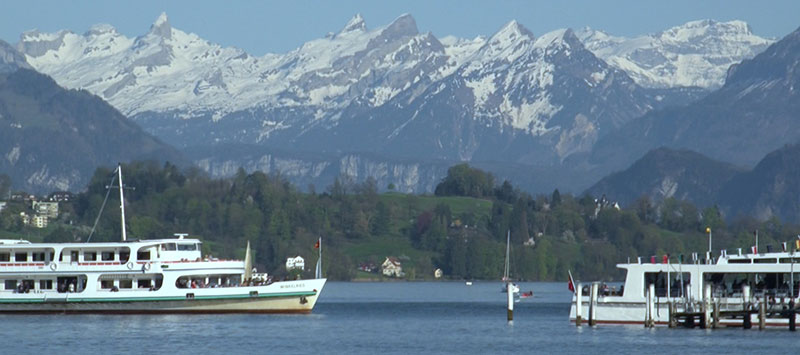
Upon arrival by train, leaving the train station you’ll see the magnificent vista of Lake Lucerne with a mountain backdrop, and the River Ruess with the Old Town behind. This delightful scene is framed by two famous Alpine peaks, Rigi, rising above the lake, and Pilatus, towering over town to the south. The picturesque setting is completed by old watch-towers, wooded hill-slopes dotted with villas, long quays bordering the lake, bridges spanning the river, charmingly embraced by exquisite mountain scenery all around.
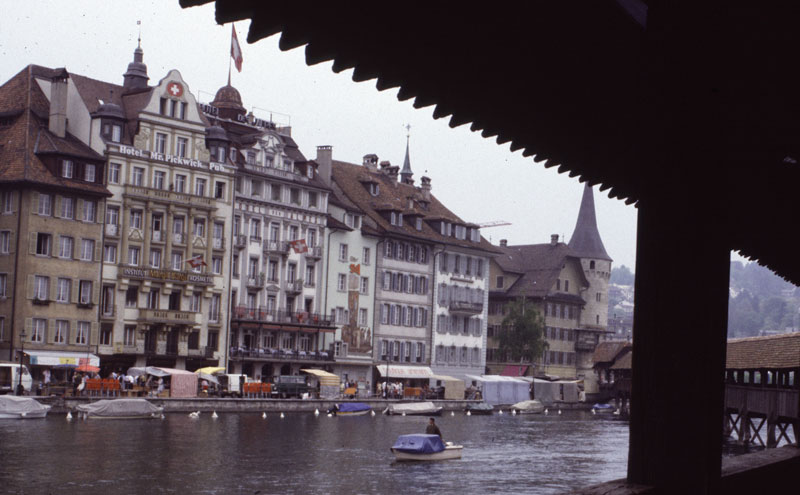
The beating heart of Lucerne is the Old Town, a compact pedestrian zone with wooden bridges, cobblestone lanes meandering through many blocks of old buildings richly decorated by painted murals showing village life in olden days – the perfect place to wander. The river flows through the middle of town, lined with cafes, restaurants and bars along the pedestrian promenade, offering grand vistas of the mountains beyond.
Switzerland does not deserve its reputation for being way more expensive than the rest of Europe, so you are bound to find some good deals. Many of the shops are unique owner-operated boutiques, with items that are pure Swiss in character, like music boxes, chocolates, cuckoo clocks, cowbells, beer steins, hand-carved wooden statues, costumed dolls, cheese, knives, embroidery, linens, music, and you can also find surprisingly good deals on clothing. Let’s not forget watches, although this heavy artillery is less important than previous due to smart phones and cheap digital imports. Some will welcome the convenience of two department stores with restaurants, Manor and Globus.
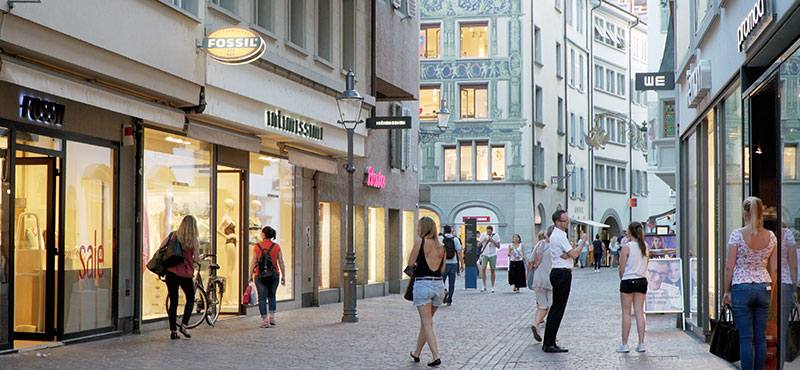
You will be happy to spend the most of a day or two walking through the historic section of town, which is about six blocks long and four blocks wide, filled with shops -- not huge, but 24 blocks that will keep you busy, with some nooks and crannies left over for tomorrow and the next day. There are three main parallel streets through the Old Town connected by a number of attractive side lanes.
The steep gabled roofs, covered with strong wooden shingles to ward off the winter snow, complete the picturesque scenario. Automobiles are not allowed into this large historic zone, so you can wander the cobbled lanes without fear of getting run over.
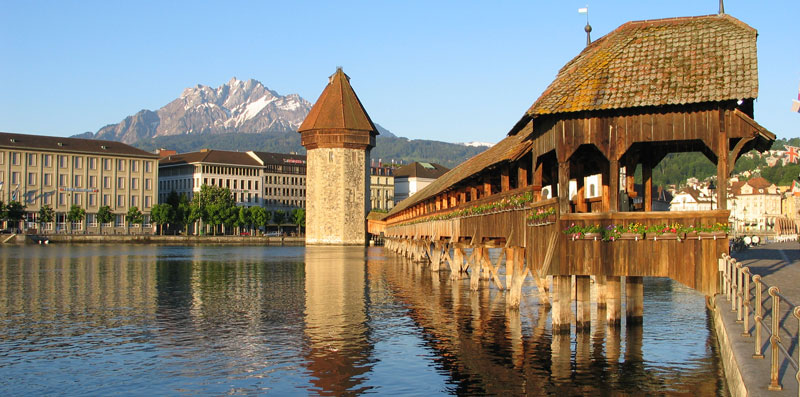
The signature symbol of Lucerne is the 560-foot long Chapel Bridge, or Kapellbrucke, the oldest covered bridge in Europe, first built in 1333, with its huge, stone tower. You want to walk across the bridge and when you do that you'll find there's a gift shop. Surprise, surprise. It's in the Water Tower, which had also been the armory for the old weapons of ancient Lucerne. There are paintings under the roof that show scenes from Lucerne and Switzerland's history. The bridge also functioned as part of the fortification of the wall that went around the city in the Middle Ages. It’s named Kapellbrucke because it begins from St. Peter's Chapel at Kapellplatz, on north side of the river.
In 1993, after 660 years, this Lucerne icon was destroyed by fire, only to be rebuilt by the efficient townspeople within a year in the original style -- and by now has weathered to a mellow patina that once again looks hundreds of years old. The heroic rise from ashes symbolizes Swiss pride in their past and modern ability to get things done. Even here, it sometimes takes forever to repair old buildings or construct new ones, but the quality upon completion is unsurpassed. Connected to the bridge is the 110-foot high Water Tower, also nearly 700 years old.
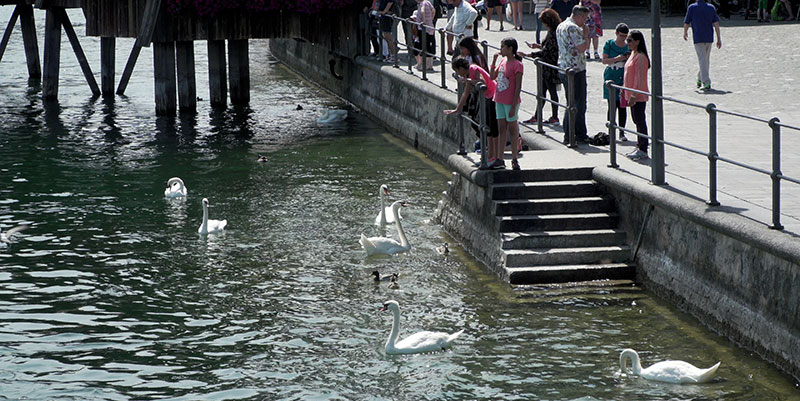
The bridge and tower are the town’s most photographed subjects, but for an unusual camera angle, lure some swans into your foreground with the bridge and tower behind. Stand on the north side of the river to the left (east) of the bridge, where you’ll notice a little staircase that goes down to the water, about 10 steps down from the sidewalk level right to the water level.
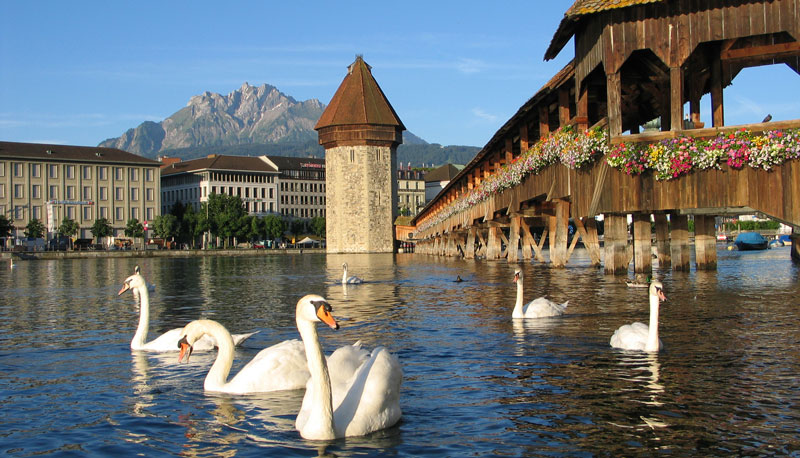
Often you will see a flock of swans paddling around, and if you walk down the steps to the water’s level you will get a spectacular photograph, with the bridge behind and on a clear day you can see Mount Pilatus in the distance, with swans in the foreground. Be cautious about feeding these swans however because there is a law against that. They take care of themselves quite nicely and if you’re caught you might get socked with a big fine. Lucerne's other signature landmark is the Lion Monument carved into the sandstone cliff, that we shall describe later when we get there in our walking tour.
One of the most enjoyable attractions are the riverside cafes, which are a special feature that makes Lucerne quite different than most other Swiss cities, which further enhance the delightful ambience of this historic old town.
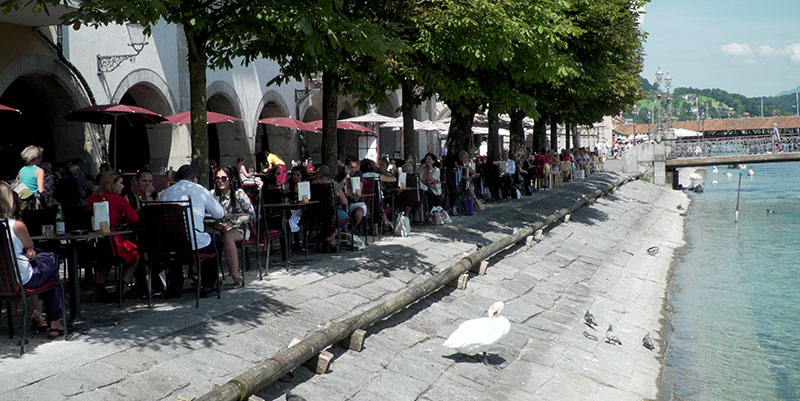
Alongside the river cafe terrace you’ve also got a whole stretch of covered arcades, like a big outdoor block party with busy restaurants and bars. You can sit at the casual outdoor cafes and just have a simple salad or a sandwich, a light meal or just a beer, while watching the parade of passing people and the swans gliding by on the River Reuss.
It's the kind of place that both locals and visitors can share in together and you'll find it's a friendly atmosphere where you might join in conversation over some beers. The weather's fine from early May through October and the action takes place all afternoon and on into the evening. Perhaps just a casual bite of sausage and fries to go with your beer or a more gourmet dinner. You'll be surprised and delighted with the variety of cuisines available in this small city. Indoor tables are usually available but almost everybody prefers to sit outdoors, a luxury they have a harder time enjoying during their winter.
Temperatures are quite reasonable throughout the year because Lucerne is at an elevation of only 1300 feet. Even in the midst of winter it’s not generally bitterly cold here, and in the summer it’s very comfortable. Some of the nearby mountains do reach 10,000 feet with snow-covered glaciers all year round but the temperatures in town are quite comfortable. The best time to visit it anytime between April and October with the summer months being especially attractive.
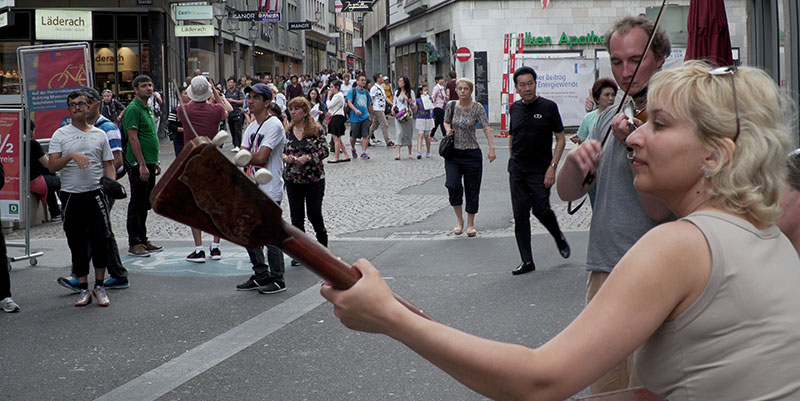
For many visitors the most enjoyable activity is simply strolling along the small lanes and plazas in Lucerne. While the main shopping lanes will attract most of your attention, be sure to have a look at the little side lanes as well. They can be a quiet respite from the busier shopping streets, and there are usually some outdoor cafe tables and little unique boutiques for you to explore. The town has lots of souvenir shops, and there's a bit of a nightclub center on a couple of these side lanes where the action goes late into the night. Parental guidance suggested.
Be sure to walk along the main pedestrian shopping street, mostly called Hertensteinstrasse, which changes names four more times. and the shopkeepers are polite and pleasant. They all speak English, so it's easy to spend your money.
Not only is it a preserved medieval town, the whole place is like a shopping mall, extending into some the side lanes, with clothing stores, department stores, chocolate shops, jewelry shops, and of course, souvenir shops.
You can easily find a map of Lucerne perhaps at your hotel or online but you don’t need to study it too closely because you can’t get lost in this small place. The Old Town is surrounded on one side by the river and lake and on the other by a hillside, an ancient fortified wall which you can climb. During the Middle Ages, Lucerne was a fortified walled town, as were many of the towns of Europe. We'll take you up there shortly.
Feel free to just wander so you can rearrange the schedules and itinerary suggested here in any way that suits your personal preference. This is a small town, so you don’t have to be too concerned about constructing any sort of efficient sequence of events. The smooth paving and rows of attractive old buildings make this a most pleasant place for meandering.
You'll discover several peaceful, small plazas in the middle of the Old Town where cobblestone pedestrian lanes come together and form charming open areas ringed by ancient buildings and sidewalk cafes, often with a fountain in the middle. Their small independent shops and a few small department stores make this a prime retail section of town.
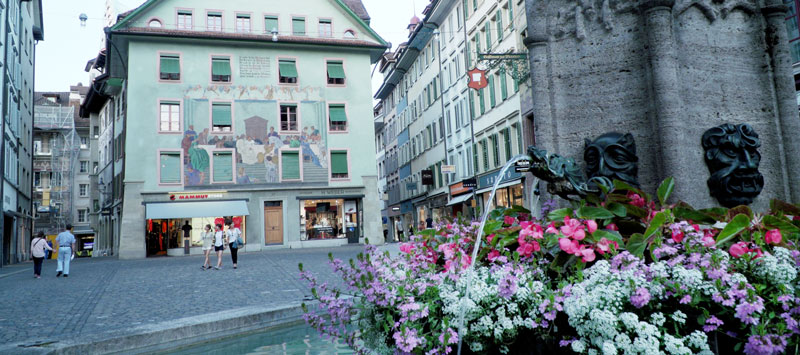
A good example is Weinmarkt, the Wine Market Square, with a beautiful painting on the far wall illustrating a biblical scene, surrounded by modern shops in old buildings, and clean water burbling from a Gothic fountain, with statue of an armored soldier. This used to be a fish market before it was the wine square, and for two centuries a Passion Play was performed outdoors during Easter season. An upper wall of a former pharmacy is painted with an epigram, “there is no cure for love.”
This plaza is also the location of my favorite Swiss hotel, Des Balances, whose exterior is also richly decorated with murals, harkening back to its time as headquarters of the saffron guild. This location has been the site of an inn since the 12th century, and served as City Hall at some point, with the current hotel opening in 1836.
.jpg)
I have led 80 tours through Europe since 1987, including 30 visits to Lucerne, which is the only city in which I have always used the same hotel. Des Balances has a magical quality with the Old Town square on one side, and rooms facing the river on the other side. There are several five-star hotels along the lake, and less-expensive choices throughout town, but the four stars here are just the thing for a luxurious splurge.
Weinmarkt was also the setting for a citizen gathering in 1332 where an oath of allegiance was declared to the new confederation with cantons of Uri, Schwyz and Unterwalden, which was the birth of the nation, the beginning of Switzerland. The country grew to its present borders about 500 years ago, now with 26 cantons, or states.
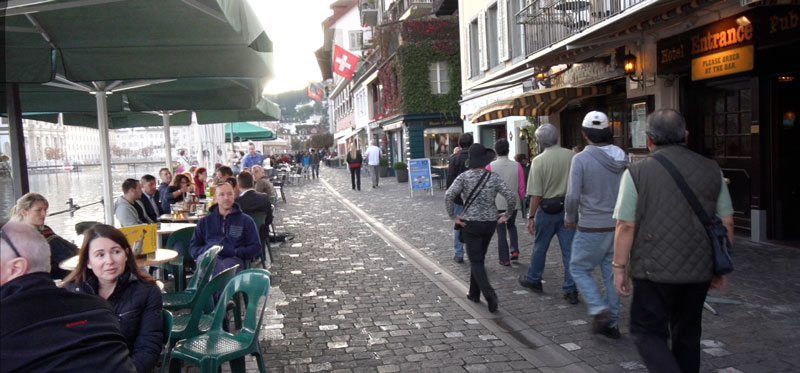
Cobblestone lanes for pedestrians wind past ancient buildings that have the most modern shops inside with everything spotlessly clean and well organized. Switzerland is the land of efficiency and charm.
Guided walking tours are offered by the tourist information office in the train station. It takes 2 hours, but you can easily walk through town on your own in a self-guided tour, especially with the tips provided here.
The layout of the Old Town is quite small and fairly orderly, but you can still get a little bit lost until you get your bearings. With the river on one side and hill on the other, you can’t stray too far off-track.
This was a very, a very civilized town as far back as 1500, when Lucerne was an important trading center located on the main route through the Alps, connecting Italy with northern Europe. That is how Lucerne became wealthy enough to pave the streets of the town, at a time when other towns just had dirt roads.
Then Lucerne became an important tourism center, particularly after the time of Queen Victoria, because she personally came down here on vacation, which was in the late 1800s, and she put this place on the map for tourism. Other famous travelers followed, including Marc Twain, who wrote about the beauties of the area.
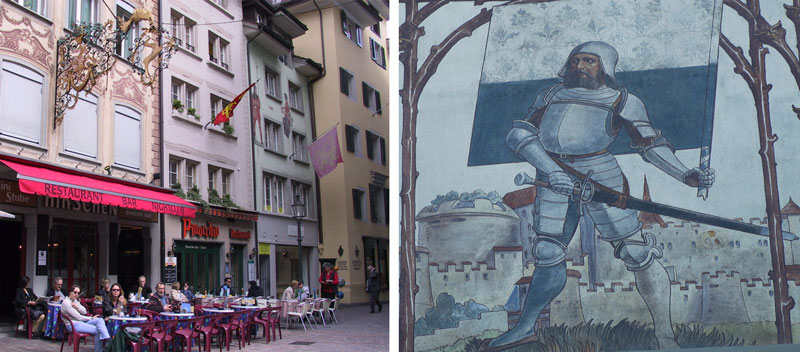
Another plaza connected to Weinmarkt is the Deer Square, or Hirschenplatz, also surrounded by buildings with murals. including armored soldiers. Typical in the medieval days, the shops would have a sign hanging out that tells you what that shop is about. You'll see a beautiful wrought iron sign with some gilding on it sticking out from the building, with a deer on it, symbolizing the name of the square. Now of course it's, a cafe, a little restaurant.
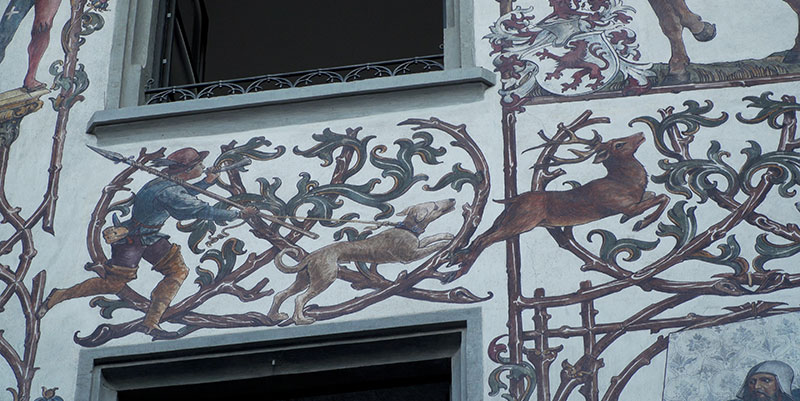
The building on the south side has beautiful painted scenes up on the wall, including some battle scenes with soldiers in suits of armor, and some boar hunting. Wild boar and venison are still very popular here in restaurants -- if they are in season, you must try it. Another building is painted with a row of golden rings, with cupids, little putis, frolicking with gold wedding bands. That was a jeweler advertising their services because a lot of their customers couldn't read, since illiteracy in the Middle Ages and later times was the norm.

Walk from the Deer Square over next door to the Town Hall tower which rises above the Kornmarkt square. Kornmarkt is the general term for a market square that sells grain of all types including wheats and barleys and it seems it has always been the center of Lucerne going back to the medieval days. Even today it's very lively with lots of bars and restaurants and shops all around it, right here in the middle of the old town. While Lucerne does not have a single official main square, Kornmarkt comes as close as you can get to that function. There are other municipal offices in town now, but this is the old City Hall, and there are still ceremonial functions that take place here, including weddings and receptions for foreign visitors.
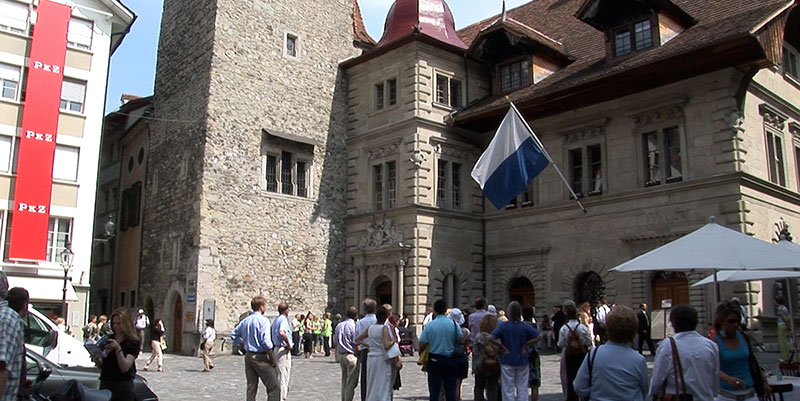
The building’s architecture recapitulates Swiss geography. Up top there is the traditional Swiss architecture of chalet-style roof with a steep pitch and wooden shingle, while the ground level looks more like Italian architecture in Florence. This layer cake of a building is Swiss-style in its north and Italian in the Ticino south.
A large ground floor room used to be where they stored the grain back starting from the early fifteenth century and now it's a multi-function space for art exhibits and special events and weddings, still carrying on some official city functions. The tower is one of the highest points in town, used as a fire watchtower while also symbolizing the importance of city government.
Something else to notice on the square is a wonderful restaurant, Pfistern, serving traditional Swiss cuisine with the bratwurst, potatoes and beer. Other classic dishes offered here are the sliced veal with the cream sauce and mushrooms, and the Lucerne pastry filled with veal, pork and Swiss meatballs.
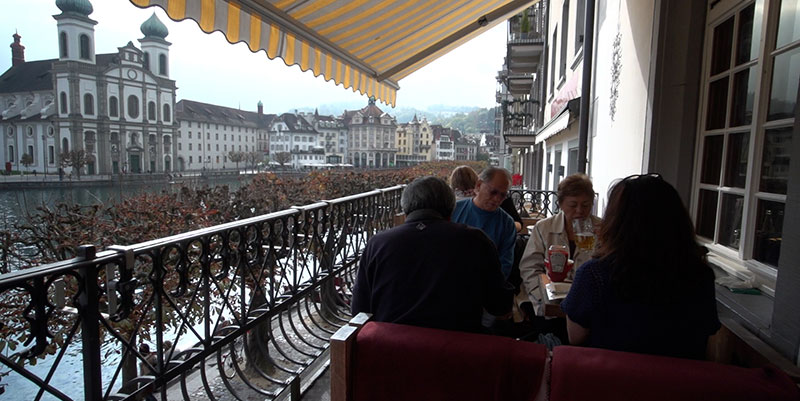
You can also get venison in season or grilled beef. There are some vegetarian choices, and other Mediterranean-style options. The cozy interior has a rustic setting of old-fashioned wooden tables, walls, floor, and chairs, or you can sit outdoors on their terrace overlooking the street and river, enjoying fresh air and a beautiful view. They also have outdoor tables downstairs in the arcade and along the river.
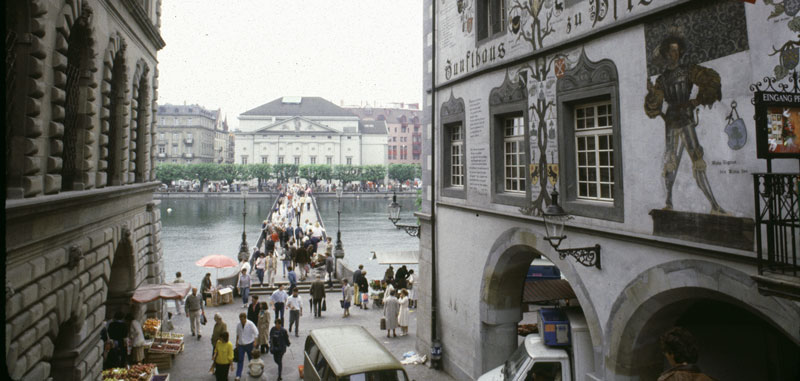
There has been a restaurant here for over a hundred years, but the building goes back nearly 500 years when it started out as the Guild for the Bakers, which was very convenient since the grain ma rket is right next door at the Kornmarkt.
Continuing from the Kornmarkt, we're walking along one of those main lanes of town, the Kapellgasse (Chapel Street) heading towards Kapellplatz, the Chapel Place, which is another one of the main squares of town, featuring a handful of regular and high-end shops.
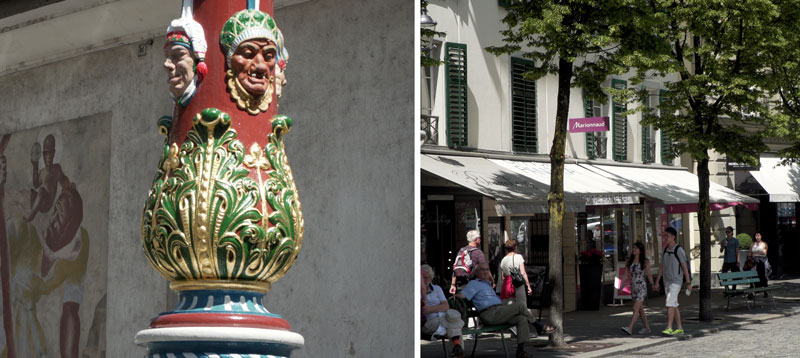
Kapellplatz is famous for its Renaissance style Fritschi Fountain built about a hundred years ago, painted with colorful characters from the Carnaval. Yes, they have Carnaval in Switzerland, just before Lent in Februrary, called Fasnacht, when conservative Swiss get dressed up in funny costumes and party for the whole week.
Up the nearby alleyway is a restaurant called the Stadtkeller, with an entertaining floor show of Swiss music, dancing, and yodeling, which goes on for about 90 minutes. They serve traditional Swiss food, or you can just go for drinks.
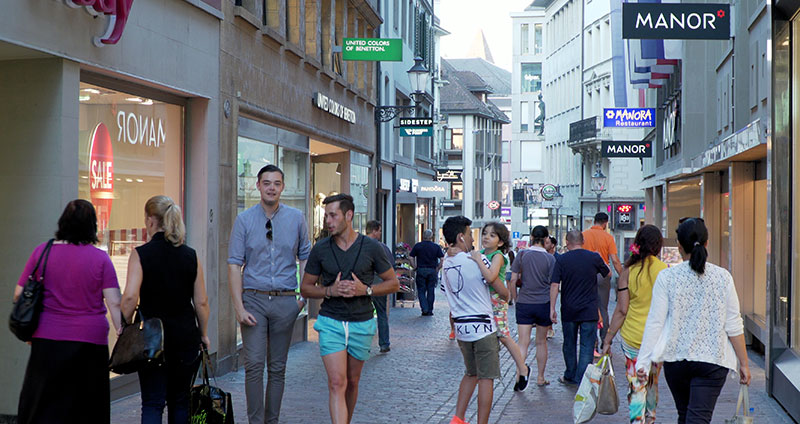
Return two blocks north to the main pedestrian lane, now called Weggisgasse, and have a look in the large Manor department store, especially to consider eating at their top-floor restaurant. They have a generous buffet where you just take what you want off of the hot table, and they'll weigh your plate and charge you accordingly. It's a pretty good value for the money, so it gets quite crowded at noon, Try to get there early or late, but they close at 6:30 most days and shut down the food by 6:00.
There are many little restaurants, snackbars and cafes, such as one block further where the pedestrian lane joins with two other streets to become Falkenplatz, with its lovely outdoor cafes.
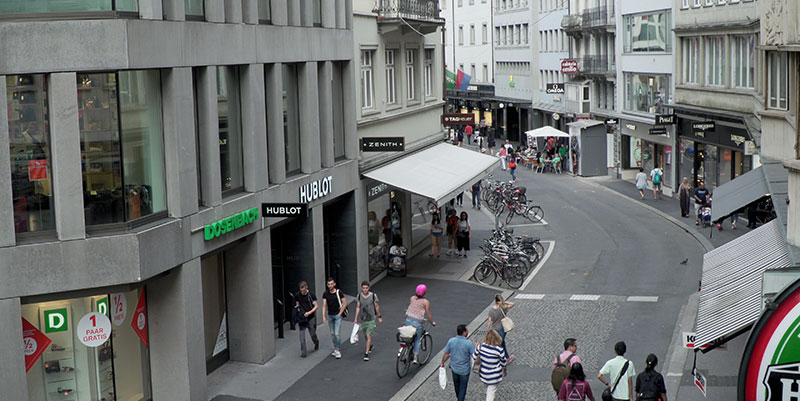
This intersection with Grabenstrasse and Grendelstrasse is one of those nice focal points of the Old Town you’ll probably pass through several times. Nearby is Emilio, famous in Lucerne as a great place to come for tea and pastries in the afternoon, or have a meal.
Continue another block towards the lake along Grendelstrasse and you'll reach Schwanenplatz with its watch shops Gubelin and Bucherer. This is a popular spot for bus tours to drop off their groups, who eagerly swarm into these reputable shops to load up on watches and related paraphernalia.
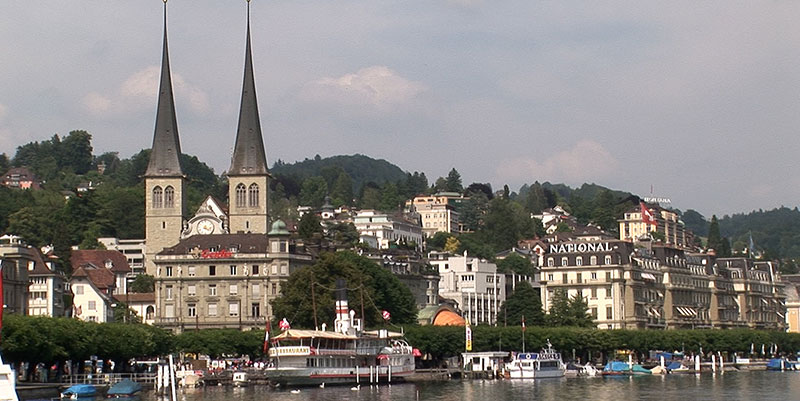
The Hoffkirche, or Collegiate Church, is another attraction in this part of town, on a hill overlooking the lake, 400 meters from Schwanenplatz. This Catholic church was built in the gothic and Renaissance styles during the 17th century and has a rich interior with many carvings and wrought-iron works, and a cloistered courtyard next door. Free classical music concerts are occasionally performed on the huge organ, or you can listen to it right now on their web site
From Schwanenplatz the next major attraction is the Lion Monument, 650 meters away, where we are heading next, but first, a few alternative options while in the area. There are some ultra-deluxe five-star hotels along this part of the Lakeshore including the Grand Hotel National and the Palace, and you will also find casinos in some of those hotels.
While you're in this neighborhood you might consider a little excursion just outside the center to the Swiss Museum of Transport, the most visited museum in Switzerland. About 2 kilometers from the center, you can get there on foot in a 1/2 hour through the beautiful park or take the city bus. It exhibits all forms of transport including locomotives, automobiles, ships and aircraft as well as communications. The old snow blower shows how they used to keep the tracks clear way back in the old days. And if you ever wondered how a rack railroad works, if you wanted to look under the car, here it is, the gear and the track. The intricate mechanical workings of the side wheel paddle wheeler are revealed for you to see. They have a number of hands-on displays where the kids can get actively involved.
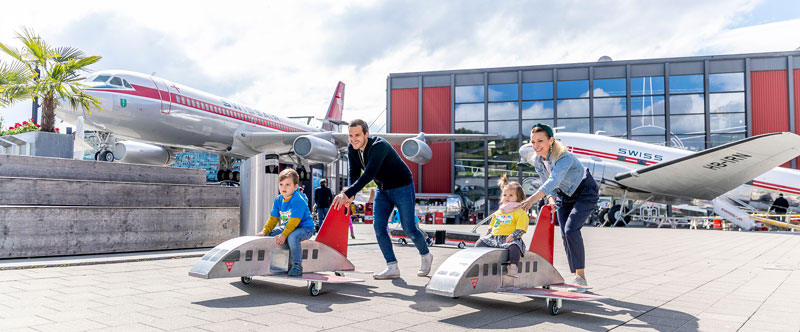
The Swiss Museum of Transport is the largest such display in the country, but it's best for those who are quite interested in seeing many kinds of old trains, cars and planes. It's 2 kilometers outside the city and can be reached by public bus or taxi or boat. https://www.verkehrshaus.ch/startseite.html Or you can walk there on the pleasant lakeside park.
Most likely when you are at Schwanenplatz, you are heading for one the town’s most popular attractions, that wonderful sculpture on a cliff.
Lion Monument
The famous Lion Monument is carved directly into the bedrock of the sandstone cliff, magnificent, but depicting a sad story. It shows a dying lion with a spear in his side, and a very sad look on his face, because it's a memorial to a great tragedy that occurred for Lucerne soldiers back in 1794 during the French Revolution.
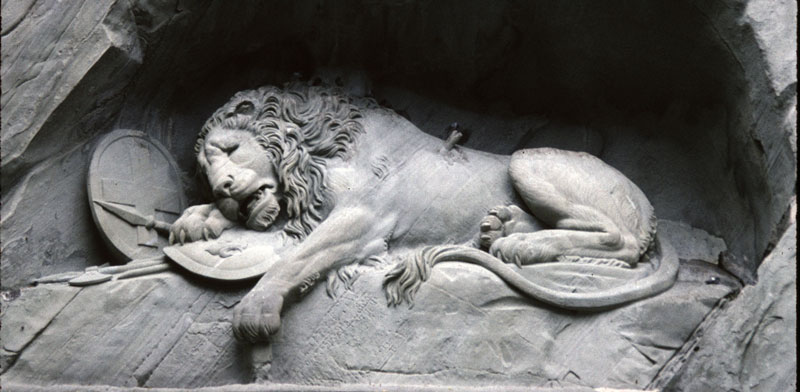
The Swiss were famous as being mercenary soldiers for hire, and French King Louis XVI was being besieged by his own people, and couldn't even trust his own army, so he had to hire the Swiss to come up and attempt to protect him. About a thousand soldiers went from Lucerne to Paris and fought in the Battle of the Tuileries, where they were defeated by the French revolutionaries. Nearly 800 Swiss soldiers were killed in the battle of the Tuileries and most of them were from the Lucerne area, so this is the commemoration of that sad event. The lion was carved in 1819, only 25 years after the event itself, and it's been here ever since. Mark Twain, who visited Switzerland, really admired the sculpture, calling it one of the finest statues that he'd ever seen. Now it is the landmark of town, along with the Chapel Bridge.
The lion is one of the most photographed objects in Lucerne, making it the perfect backdrop for your selfie or group shot. It's been getting increasingly crowded so you might have to wait your turn.
There's an excellent souvenir shop right across from the lion monument, called Schmidt-Linder, with one of the largest selection of Swiss gift items in town. The shopping is fun with many items that are pure Swiss in character, such as music boxes, watches, cuckoo clocks, cowbells, beer steins, hand-covered wooden statues, costume dolls, Swiss Army knives, embroidery, linens and you can also find very good deals on clothing.
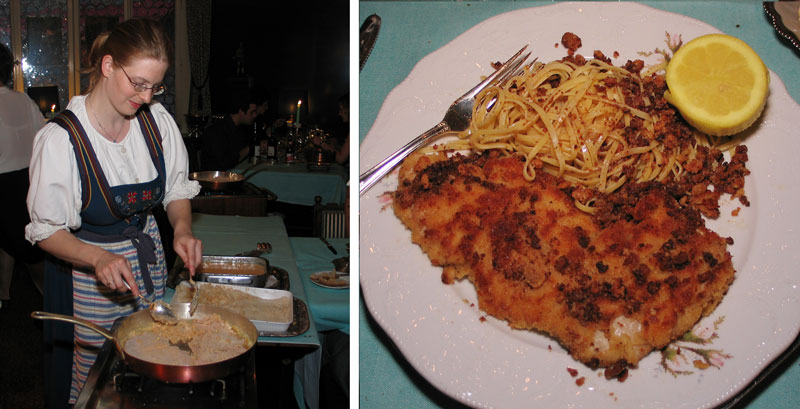
Another great attraction right near the lion monument is the Old Swiss House, one of the best restaurants in Lucerne. It's been here for three generations of family still running the restaurant today, a real institution in town, serving excellent food.
They have the best wiener schnitzel ever, cooked right at your table, with lots of butter, breadcrumbs and secret ingredients. Once in a while you have to treat yourself like that to a super meal, a wienerschnitzel meal and they can do it for you. They also have fish from the lake and a big menu. I highly recommend this place.
That completes our look at this part of town in Day One, so maybe you’ve seen enough for now and it is time for some rest to get ready for another big one tomorrow.